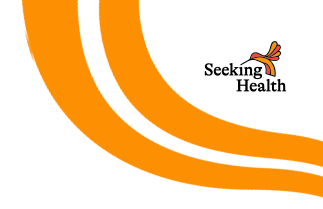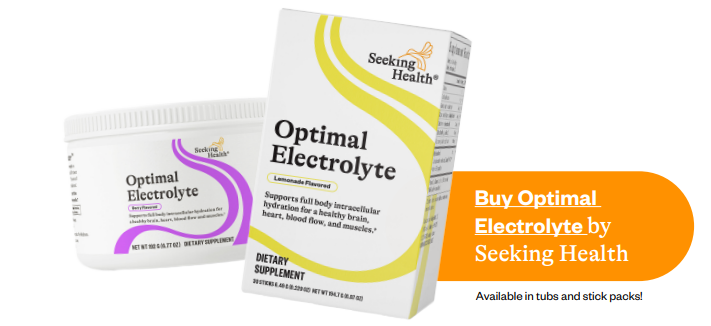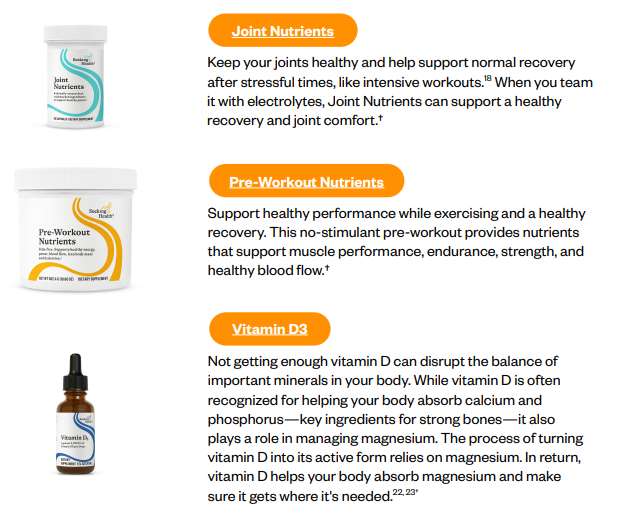How to use Electrolyte GuideUpdated a month ago

 Over 70% of your body's water is found inside your cells.1 Optimal Electrolyte is a uniquely formulated electrolyte designed to support healthy intracellular hydration. The intracellular hydration is made possible due to the higher ratio of potassium to sodium, added creatine and taurine, along with the PeakATP.†
Over 70% of your body's water is found inside your cells.1 Optimal Electrolyte is a uniquely formulated electrolyte designed to support healthy intracellular hydration. The intracellular hydration is made possible due to the higher ratio of potassium to sodium, added creatine and taurine, along with the PeakATP.†
| Ingredient | DEFICIENCY SIGNS AND SYMPTOMS | ESTIMATED PREVALENCE OF DEFICIENCY ( HAIR ANALYSIS ) (24) | % O F T H E U S A D U LT POPULATION BELOW THE RECOMMENDED DAILY INTAKE (25) |
| SODIUM | Headaches, low stomach acid, confusion, restlessness, irritability, insulin resistance, brain fog, muscle weakness and spasms, difficulty breathing, and nausea. | 6% | An astonishing 90% of the population consumes sodium that exceeds the recommended daily intake. |
| POTASSIUM | 37% | 97% | |
| MAGNESIUM | 49% | 61% |
Electrolytes have been researched to support the following areas of health:†
| • Hydration1, 2 | • Kidneys10 |
| • Energy3 | • Immune system function11, 12 |
| • Muscles4, 5 | • Pregnancy and breastfeeding14, 15 |
| • Nerves and brain6, 7 | • Bones16, 17 and Joints13 |
| • Heart8, 9 |
How do electrolytes support these areas of health?†
• Increase real hydration by supporting healthy water levels inside the cells (70% of water is found inside your cells)
• Support healthy glucose uptake and utilization in the brain
• Support healthy muscle function
• Support healthy nerve signal transmission
• Support healthy cognitive function
• Support a healthy blood-brain barrier that protects the brain
• Support healthy immune system function
• Support healthy histamine levels
• Support healthy blood pressure and fluid balance
• Support healthy amniotic fluid during pregnancy
• Support healthy breast milk production and quality
How to take Optimal Electrolyte:
• Add a scoop to a glass or bottle, then fill it with 8 ounces of filtered water
. • For better results, sip and hold, then swallow. Do not chug
. • This is a low-sodium electrolyte, as 90% of people get sufficient sodium in their diet.
• This is a high potassium electrolyte, as 97% are below the daily intake levels
. • Add extra salt if you’re sweating excessively or not getting enough from your diet (¼ tsp of salt = about 575 mg of sodium).
• Ask your healthcare professional how much you should take.
Take Optimal Electrolyte, especially in the following scenarios:†
• Upon waking in the morning to replenish hydration levels lost during sleep.
• Before, during, or after exercise.
• While traveling by air, car, or boat.
• During sun exposure.
• While studying or working for better cognition.
• While using saunas.
• When exposed to wind.
• When temperatures are high.
• When humidity is too high or too low.
• If you are vegan or vegetarian, as creatine and taurine are only found in animal foods.
• When sick and experiencing symptoms like fever, vomiting, or diarrhea to support optimal hydration levels.
• When you have too much caffeine or alcohol and need to support healthy hydration.
• If you are pregnant or breastfeeding
Avoid taking Optimal Electrolyte during these times:
• 3 hours before bedtime because ATP keeps you awake.
• With meals, as it can neutralize some of your stomach acid
When to be careful taking Optimal Electrolyte:
• If you have any pre-existing health condition that affects electrolyte balance, such as problems with the heart, kidney, or liver, eating disorders, or cancer.
When to stop using Optimal Electrolyte:
• If you start presenting signs of excessive use of electrolytes.
• If you experience any health condition that affects electrolyte balance.
• If you start a new medication that affects electrolyte balance
Signs of excessive use of electrolytes:
• Abdominal pain, nausea, vomiting, diarrhea, or loss of appetite.
• Water retention (high sodium).
• Irregular heartbeat.
• Low blood pressure (high potassium).
• High blood pressure (high sodium).
How to counter the side effects of excessive electrolytes:
• Consult a healthcare professional immediately.
• Discontinue use or reduce the dosage or reduce the frequency of use, depending on the severity of symptoms.
• Cut back on eating foods rich in minerals (electrolytes), like leafy greens, beans, and fruits.
• Reduce sugar and carbohydrate intake until better.
Lab testing for electrolytes:
• Is not very accurate as it won’t show intracellular levels of electrolytes.
• Doesn’t always identify a deficiency because the body works very hard to maintain a balanced electrolyte status.
• A serum electrolyte panel can be ordered but will not pick up a mild electrolyte deficiency.
• RBC magnesium, serum calcium, and a sodium-to-chloride ratio are helpful.
• Hematocrit is a useful marker to determine overall hydration status, but it’s not definitive.
• Plasma osmolality elevation shows dehydration.
• Physical signs of electrolyte deficiencies are a better indicator of need.
Who can take Optimal Electrolyte?
| • Adults | • Children ages 4 and up |
| • Teenagers | • Pregnant and breastfeeding women |
| • Elderly | • Vegans and vegetarians |
| • Athletes |
How long do electrolytes stay in the body?
This depends on multiple factors:
• Sodium typically stays in the body for 24 to 48 hours.
• Potassium is retained for several days.
• Calcium and magnesium are stored in the bones providing longer-term storage.
• Sodium is easily achieved through foods in the diet.

Supportive supplements for Optimal Electrolyte:


Always consult with a healthcare professional before starting any new supplement, especially at higher doses.
References
1. https://link.springer.com/chapter/10.1007/978-3-030-20335-1_10
2. https://pubmed.ncbi.nlm.nih.gov/29021321/
3. https://pmc.ncbi.nlm.nih.gov/articles/PMC8850977/
4. https://pubmed.ncbi.nlm.nih.gov/31082167/
5. https://pubmed.ncbi.nlm.nih.gov/7854827/
6. https://www.ncbi.nlm.nih.gov/books/NBK539791/
7. https://www.sciencedirect.com/science/article/pii/S0735109710049764?via%3Dihub
8. https://pmc.ncbi.nlm.nih.gov/articles/PMC7692015/
9. https://pubmed.ncbi.nlm.nih.gov/29543505/
10 https://pmc.ncbi.nlm.nih.gov/articles/PMC4525130/
11. https://pubmed.ncbi.nlm.nih.gov/35056870/
12. https://pmc.ncbi.nlm.nih.gov/articles/PMC8840645/
13. https://pmc.ncbi.nlm.nih.gov/articles/PMC9460692/
14. https://pubmed.ncbi.nlm.nih.gov/37049579/
15. https://pubmed.ncbi.nlm.nih.gov/9290089/
16. https://www.ncbi.nlm.nih.gov/sites/books/NBK541123/
17. https://pubmed.ncbi.nlm.nih.gov/38346690/
18. https://pmc.ncbi.nlm.nih.gov/articles/PMC3737804/
19. https://pubmed.ncbi.nlm.nih.gov/28914794/
20. https://pubmed.ncbi.nlm.nih.gov/25462582/
21. https://pmc.ncbi.nlm.nih.gov/articles/PMC4772032/
22. https://www.imrpress.com/journal/IJVNR/84/1-2/10.1024/0300-9831/a000190
23. https://pubmed.ncbi.nlm.nih.gov/19402296
24. https://pubmed.ncbi.nlm.nih.gov/11735305
25. https://pubmed.ncbi.nlm.nih.gov/21865568/
